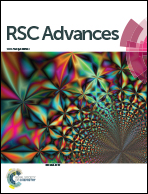Elastomers uploaded electrospun nanofibrous membrane as solid state polymer electrolytes for lithium-ion batteries
Abstract
A new class of thin, safe and foldable solid composite electrolytes are produced by uploading 3-arm poly-(methoxy-poly(ethylene glycol) methacrylate) (3PEG) onto three different electrospun membranes, poly(vinylidene fluoride-co-hexafluoropropylene) (P(VdF-HFP)) membrane, 3PEG co-sprayed P(VdF-HFP) membrane (3PEG/PHP) and polyethylene terephthalate membrane (PET) and are named 3PEG@PHP, 3PEG@3PEG/PHP and 3PEG@PET, respectively. The electrospun membranes serve as a skeleton to enhance the mechanical strength of composite electrolytes, whereas 3PEG filled in the micropores of the matrix affords an ion transport carrier. Among these composite electrolytes, the one based on a PET electrospun membrane exhibited a high ionic conductivity of 5.9 × 10−4 S cm−1 at 100 °C because of it possessing the lowest shrinkage rate with high filling loading of 3PEG. The decomposition potential of the composite electrolytes is above 4.5 V at 100 °C. Successful charge and discharge cycling of 3PEG@PET based all solid state lithium ion battery have maintained the initial discharge capacity of 137.6 mA h g−1 at 0.1C, which proves that they are ideal candidates for all solid state rechargeable lithium ion batteries.


 Please wait while we load your content...
Please wait while we load your content...